Windows does not load on acer laptop. Acer eRecovery. Full description
Before asking a question in the eRecovery thread, please check the following:
1. The presence of a hidden section in the system. To do this, just go to the "control" menu by clicking right click mouse on the icon "my computer" and select the menu "disk management". If you have Windows XP preinstalled, you will see the first section labeled "PQService" ("EISA" configuration) in size from 2.5 to 5 GB. If you have a pre-installed system - Windows Vista, then, as a rule, the first partition is visible without a label (also the "EISA" configuration) and has a size of 9 GB and more. In the absence of such a section, you should look for a solution to your problem in the topics for restoring / creating a hidden section.
2. The presence of a workable hidden partition in the system. Sometimes it happens that when installing the operating system, the user accidentally or intentionally deleted the first (hidden) partition and did not remove the "D2D Recovery - enable" function in the BIOS. In this case, when installing the original mbr from Acer, an empty hidden partition is created or the first partition where the user installed operating system, marked as hidden and inactive ("EISA" configuration). In the latter case, of course, the operating system will not be loaded, since the computer will try to boot from the second partition. Only pressing hot keys "Alt-F10" will launch the first partition and, accordingly, the installed operating system. Hence, you need to check the contents of the hidden section. It is not difficult to do this using the mbrwrwin.exe program (with the command in command line mbrwrwin mount hd0: 1 X :). This program allows you to mount a hidden partition (assigns a drive letter to it), and its contents can be viewed in Explorer. If you are experiencing difficulty in mounting, then you can use this program. The peculiarity of the program in Windows environment Vista: when launched "as administrator", the hidden section will be visible only in the command line, you will not see it in the explorer. To view the contents, use the dir X command: (X: - the letter of the mounted partition, it can be any, for example, for the above program the drive is assigned the letter N :). If you just run the program (on behalf of the current user), then the hidden section will be visible in the explorer, but you will not be able to do anything with the files, only view the contents. In the case of a non-working hidden partition (empty or the operating system you installed is located there), you should also look for a solution to your problem in the topics for restoring / creating a hidden partition, as indicated above. After restarting the computer, the PQService section will be hidden again.
3. Enough free space on the system partition (the partition where the OS is being restored / installed). Windows Vista and Windows 7 require a partition of at least 30-35 GB respectively. If there is not enough free space, problems may arise when using the recovery discs.
So, if you have a hidden section and you are experiencing problems with its use, then carefully read the answers to frequently asked questions and only if there is no solution you need, ask your question in the topic.
Question: How to start System Restore from a hidden partition?
Answer: By simultaneously pressing the Alt and F10 keys when the computer boots up (at the time the Acer logo appears). Tip: hold down the Alt key and press F10 repeatedly. It doesn't always work the first time, so try it a few times.
Question: The Alt + F10 keyboard shortcut does not work. How to be?
Answer: In the overwhelming majority of cases, a non-original mbr (from Acer) is installed. Use this patch to fix the situation (in Windows Vista, run "as administrator" by right-clicking).
Question: The hidden partition (eRecovery management) has started, but the program requires a password to restore the system.
Answer: The default password for the recovery system is six zeros (000000). Sometimes - AIM1R8. In order to change / remove it, you need to make the appropriate changes in the Empowering Technology application or in the aimdrs.dat file located in the hidden section (how to mount / open it - see above). The aimdrs.dat file can be edited in notepad (the password is specified explicitly) or deleted, then the password will not be requested in the future.
Question: When starting "restore factory configuration", the error "FAIL to get Disk 0 partition 3 drive letter" appears
Answer: An error occurred while assigning a letter to a section due to an incorrect operation on sections. Launch eRecovery Recovery Console (by Alt-F10) and press Alt-Home, Command Prompt will appear. If you cannot do this, use a bootable disk with Vista or Windows 7. Boot the computer from the disk and select the "recovery-command line" items. At the command prompt, enter:
diskpart
sel disk 0
list part
In the list that appears, see if there is a 3rd partition (Partition 3), whether it belongs to a data partition (usually drive D). If the section is in place and is primary, then try assigning a letter to the section with the command:
sel part 3
assign letter = E
exit
After the reboot, drive E will become drive D, and the recovery will take place in the usual way... If the disk is not formatted, then run:
sel part 3
format quick label = DATA
assign letter = E
Question: When installing the eRecovery application, the system reports the error "Not D2D System. ERecovery can not be installed ..."
Answer:
1. There is no hidden section.
2. An attempt was made to install the wrong version of eRecovery. To clarify the version you need, open the napp.dat file located in the hidden section in notepad (how to open / mount it - see above). So:
NAPP 1.x.x or NAPP 3.2.x.x - eRecovery version 1.2.х.х (image created using GHOST program)
NAPP 3.3.x.x - eRecovery version 1.3.х.х (hereinafter, the image was created using the WASAY ImageIT program different versions, extension * .wsi)
NAPP 4.0.x.x - eRecovery version 2.0.x.x
NAPP 5.x.x.x - eRecovery version 2.5.х.х (this version and higher is used for preinstalled Windows Vista)
NAPP 6.x.x.x - eRecovery version 3.0.x.x
Question: When installing the eRecovery application, the system reports the error "Old NAPP Version ..."
Answer: Installing the wrong version of eRecovery (see previous answer).
Question: When installing the eRecovery application, the system reports the error "Not Acer System ..."
Answer: Some parameters are not indicated in BIOS (model, computer manufacturer, etc.). It is very important to have an Asset Tag - Acer. To solve the problem, you need to use special utility dmitools.exe. The program works under DOS, so use a bootable disk or other media to be able to work in this environment.
Dmitools.exe program commands:
[/ R | / WP | / WS | / WU] [STRING]
: Read DMI Information from Memory
: Write Manufacturer Name to EEPROM. (Max. = 16 characters)
: Write Product Name to EEPROM. (Max. = 16 characters)
: Write Serial Number to EEPROM (Max. = 22 characters)
: Write UUID to EEPROM. (Ignore String)
: Write Asset Tag to EEPROM. (Max. = 32 characters)
For example: dmitools / wa Acer System
dmitools / wm Acer
dmitools / wp Aspire 5730
Question: The installation of the eRecovery application takes an indefinitely long time, the system does not freeze and you have to shut down the application yourself.
Answer: Invalid structure hard disk... If Windows XP is preinstalled, then three partitions are required (1st PQService, 2nd Acer - system, 3rd ACERDATA). If Windows Vista is preinstalled, then you need either three partitions (see above), or four (if you have the Instant-On-Arcade function, which allows you to launch a multimedia application without loading the main operating system). In the latter case, the first and fourth partitions are hidden, the other two are Acer and Data.
Question: When installing the eRecovery 3.x.x application, the error "eRecovery can not be installed - 1. Bootable File" appears. How to be?
Answer: This error means that the hidden partition is missing the files required to create the recovery disc. Mount the hidden partition and look for the acerboot.iso file in the root of the partition.
Question: When installing the eRecovery 3.x.x application, the error "eRecovery can not be installed - 6. SoftwareDisc" appears. How to be?
Answer: You need to create the C: \ Acer \ Preload \ Autorun folder and copy all the files from the Applications \ Drivers disk that was previously created with the eRecovery application to this folder.
Question: When installing eRecovery v6 (Windows 8), the error "Hard disk not set to default configuration" appears. How to be?
Some versions of eRecovery require the C: \ OEM \ Autorun \ Preload folder to work properly.
All questions are expressed in this forum thread:
Material prepared specially for http: // site (author - Denis Guriev, GDenis)
e-mail [email protected]
(change of material, copying and distribution only with the permission of the author)
To make life easier for users, Acer has developed technology eRecovery which includes the application itself Acer eRecovery, as well as a hidden partition on the hard drive with a volume of several gigabytes. As a rule, on Acer laptops this section is called PQService... Main function Acer eRecovery- restoring the operating system along with preinstalled programs and drivers as at the time of purchase of the laptop. Looking ahead, I note that to restore the operating system with programs and drivers, you must press when the laptop boots up at the time of appearance white screen with an inscription Acer keyboard shortcut ALT + F10... On laptops ASUS, for example, you need to press the key F9... Information from the C: drive is erased, but from D: and other partitions - not. As a result, in about an hour the laptop will have an OS with programs and drivers as at the time of purchase.
Consideration of technology Acer eRecovery it is logical to start with a description of the program Acer eRecovery which comes pre-installed on Acer notebooks. At the first start, this program asks for a password:

Click on the button Setup and then on Create New a Password
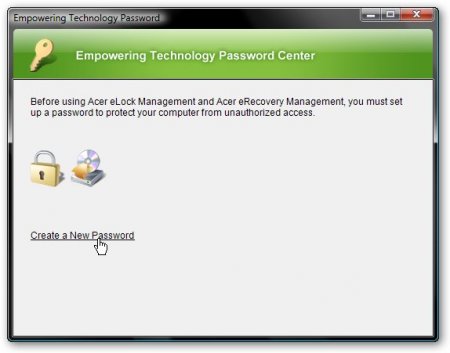
In the upper window, enter the password, on average, enter it again for confirmation, and in the bottom window, enter the hint
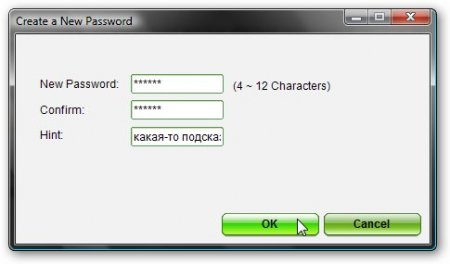
If everything went well, we get such a window and click OK

I will explain why that password. It must be entered when restoring the system. Recovery will not start without entering this password. It's done Acer for security. When restoring, all information from the C: drive is erased. If an unauthorized person gains access to the laptop, then he can intentionally / unintentionally press ALT + F10 while loading and all information (including valuable information) on the C: drive would be erased. But if he does not know the password, then he will fail. If you do not know the password, you can find it out by reading
Now let's go directly to the program itself. At the bottom of the main window you can see 3 tabs Backup, Burn disc and Restore... I will describe the tab first Backup
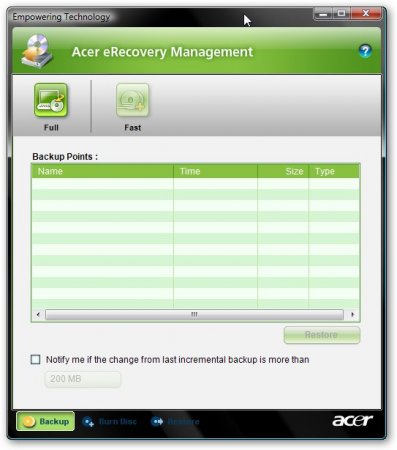
At the top you can see 2 buttons Full and Fast... I will explain why they are needed. If you press the button Full, then the process of creating a system restore point will begin, in other words, the entire contents of the disk WITH: is archived and at any time you can restore the state of the system at the time of the backup. The process of creating a restore point begins by specifying its name:
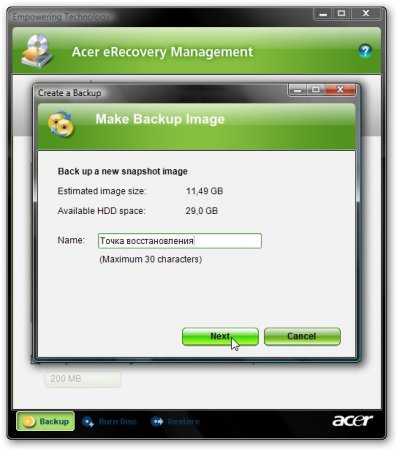
We press Next and a window appears with a warning that the restore point takes up quite a lot of disk space and it is recommended to close all applications before starting the backup process:

We choose Yes and click Next... After that, the process of creating a restore point starts:
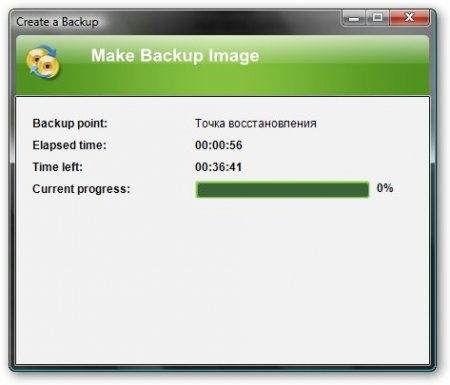
When the creation is complete, click OK
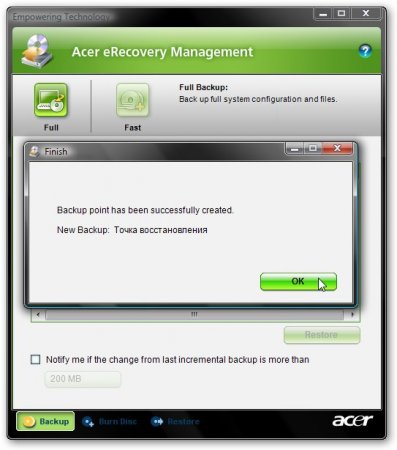
Now I will explain what the button is for Fast
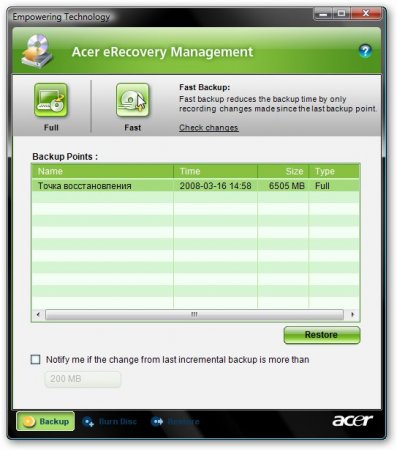
By clicking on this button, we start the incremental archiving process. This means that only changes are recorded in the archive compared to the original archive, which we made by clicking on the button Full... The modified files take up significantly less space and the archiving process is much faster. At the bottom of the main window, you can check the box next to Notify me if the change from last incremental backup is more than This checkbox enables notifications if the size of changes since the last incremental archiving exceeds a certain amount, which is indicated in the window. The incremental backup process begins by specifying a recovery point name:

Then the program asks us to close all applications before starting archiving, and also notifies that the archive takes up a certain amount of space on the hard disk. To start the process, select Yes and press Next
When the archiving process is completed, click OK

As a result, we will have one complete archive, which contains all the information from the C: drive, as well as one incremental archive, which contains only the changes after the creation of the main archive.

If we want to restore the state of the system (more precisely, the contents of the C :) drive at the time of archiving, press the button Restore... Recovery archives are stored in hidden folder D: erData
Moving on to the description of the tab Burn disc... We have already encountered it in.
There are 4 buttons on it:

Create factory defeault disc- by clicking on this button, we will start burning recovery discs from which you can restore the entire system with drivers and programs as at the time of purchase of a laptop. It is necessary to make these discs MANDATORY
Create user backup disc- writing a restore point to disks, which is essentially the archived contents of the C: drive. This button will be active only when a full archive is made (to create it - on the tab Backup we press Full).
Create current system configuration backup disc- if you click on this button, then the contents of the C: drive are first archived, and then written to the disks.
Create- distributions of all programs and drivers that come with the laptop are written to the disk. This disk is necessary MANDATORY make.
When you click on the buttons, the following entry window opens:

The top indicates how many disks are needed. To start recording, click Next
Consider the tab Restore

This tab, like the previous one, contains 4 buttons. I will describe them in order:
Restore system to factory defeault- OS recovery with drivers and programs from hidden partitions. Information from the C: drive is erased, but not from other drives.
Restore system from user "s backup- restore the system from the user's restore point.
Recover system from CD / DVD- OS recovery with drivers and programs using Factory defeault disc
Reinstall applications / drivers- reinstall programs and / or drivers. If you click on this button, this window will open:
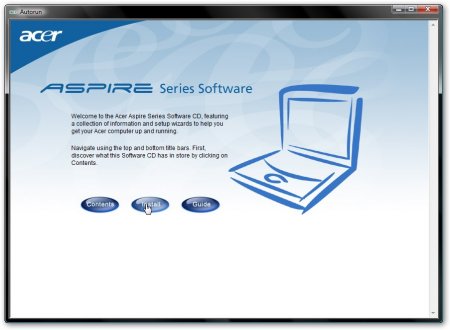
We press the button Install and in the menu on the left, select programs or drivers:
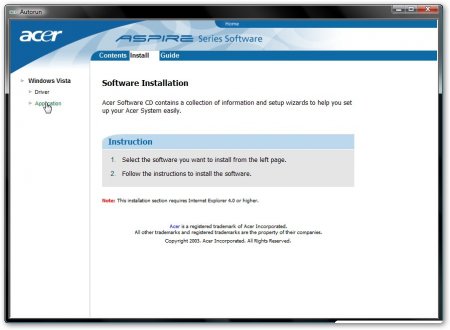
In the list, we are looking for the application / driver we are interested in and click Install ... for installation:

I think this is where we can finish with the description of the utility. Acer eRecovery
Now let's move on to the fun part - hidden sections.
It makes sense to start looking at hidden sections with brief description their contents. In order to view the contents of the hidden partitions, we will use the Acronis True Image 10 utility (mirror) and directly the images of the hidden partitions. How to do them is described
Launch Acronis True Image 10 and on the menu Tools select item Explore Backup Archive
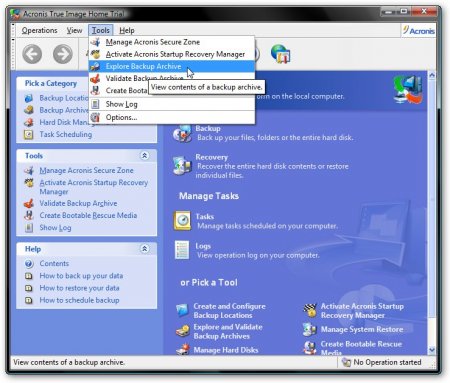
Select the image of the hidden section (if the image consists of several pieces, then select the first one) and click Open

We open the archive. The screenshot shows the approximate contents of the section PQService
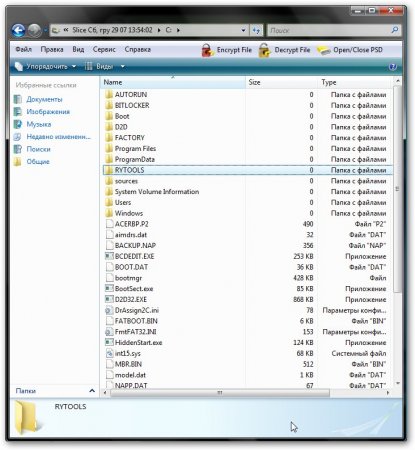
In folder RYTOOLS there is a utility for working with and directly the MBR itself.

In folder D2D / IMAGES posted a recovery image of partition C: laptop:

And here is the content of the second hidden section NTFS laptop Acer aspire 5920
![]()
This section is used to implement the Acer IOArcade technology - loading a media center based on a stripped-down Windows versions XP when pressing the button with the little man on the right. This section contains Windows XPe and Acer Arcade.
I will describe how you can restore this partition with only Driver & application backup disc... To do this, using the utility for working with partitions (Acronis Disc Director Suite 10, for example), create a regular NTFS partition with a volume of 3.248 GB at the end of the hard drive, create a file in notepad that contains 11 units (11111111111 ) and call it Arcade.dat... Move this file to the created 3.248GB partition. Then all that remains is to find on Driver & application backup disc folder IOArcade and start the installation.
If someone needs an image of the hidden section of IOArcade - DOWNLOAD FROM HERE(thank you so much Sleganzov)
We have superficially sorted out the structure of hidden partitions, now we will consider the issue of their recovery. For this we need:
- made Acronis True Image images of sections. .
- Acronis True Image 10 (I do not recommend version 11 because of possible blue screens
while loading)
- Acronis Disc Director Suite 10 ( This program offered for informational purposes only. By using this program, you agree to uninstall it within 30 days or purchase to continue using, copyright must be respected)
- It is recommended to download this bootable disk image as well, which may help recovery. (This program is offered for informational purposes only. By using this program you agree to uninstall it within 30 days or purchase it to continue using, copyright must be respected)
Suppose that when restoring hidden partitions, we repartition the hard drive and install Windows XP. The recovery procedure for Windows Vista is the same. Hidden partitions are stored on drive D:
Warning: any operations with partitions pose a potential risk to your information. Therefore, it is better to write all critical information to discs or to another computer.
Let's start. First of all, we need to find out the exact size of the hidden partitions. To do this, run Acronis True Image 10 and click Try now... Demo still
![]()
On the menu Tools select item Explore Backup Archive
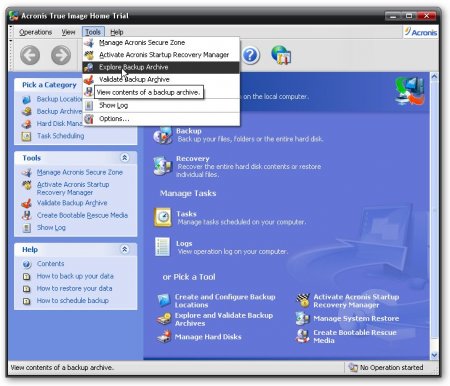
We select first the first section

and see its size. In our case, this is 9.759 GB ... we write this figure somewhere on a piece of paper
Then we select the second one (if you have only one hidden partition on your laptop, skip this step)

rewrite the size to the same piece of paper. In our case, it is 3.241 GB
Launch and select from the menu Manual mode (Manual mode)
The program window opens. At the top we see a list of partitions on the hard drive.
Note: If the size of the C: drive is less than 20 GB, then it is recommended to first reduce the size of the D: drive and, at the expense of the free space, increase the size of the C: drive to 20 gigabytes or more. This is necessary so that the C: partition does not overflow during the recovery process due to its insufficient size.
While resizing with Acronis Disc Director Suite 10 information NOT REMOVED.
When we have put things in order with the size of the C: drive, then you can proceed to the direct restoration of the partition (s) .First of all, you need to create using Acronis Disc Director Suite 10 free areas with dimensions that correspond to the dimensions of the hidden partitions. We will create these areas by reducing the size of the D: drive. When creating free areas for partitions, it is VERY IMPORTANT that their placement on the disk matches the original. That is, if the hidden partition was at the beginning of the disk, then the area for it must be created at the beginning of the disk, if the hidden partition was originally at the end of the disk, then you need to create an area of free space for the hidden partition at the end of the disk. This is a very important point, otherwise it is quite possible that automatic recovery will not want to work.
To create free areas, click on the D: drive with the right button and select Resize

This window opens:
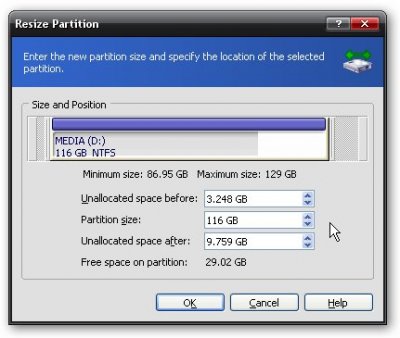
Unallocated space before- this window sets the size of the free area in front of the section. In our case, the hidden section NTFS should be at the beginning of the disk, so we indicate its size, which was previously rewritten from Acronis True Image 10 PQService and it is located in BEGINNING DISC Unallocated space after leave zero.
Unallocated space after- this window sets the size of the free area after the partition. In our case, the section is a hidden section PQService should be at the end of the disk, so we indicate its size, which was previously copied from Acronis True Image 10... If you have only one section - PQService and it is located in DISC END, then we indicate its size in this window. In this case, in the field Unallocated space before leave zero.
Push OK and we get something like this. Everything is as we asked. Before partition D: 3.248 GB of free space, and after that - 9.759 GB. Now we need to move the C: partition so that at the very beginning of the hard drive free space the size that we set in the field Unallocated space before when the D: partition was resized. If you have only one section, which is located in DISC END, you can skip this step because there is no free space in front of the D: section and there is simply nowhere to move the C: section. After the D: drive, you should have a free area with a size equal to the size of your hidden partition.
We click on the C drive: right-click and select from the menu Resize

In the window that appears, simply move the C: section all the way to the right:
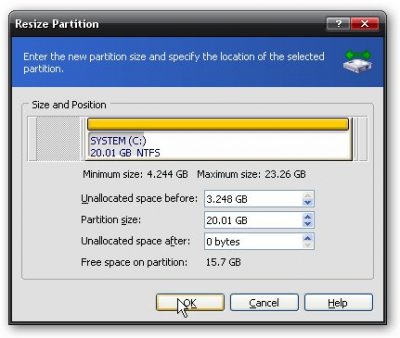
Push OK and we get something like this
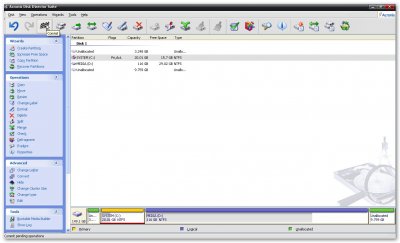
Unallocated area in front of drive C: for partition NTFS and an unallocated area for the section PQService after drive D:
Note: all changes are carried out after restarting the laptop, any change can be canceled by clicking on the blue arrow at the top of the program.
To apply the changes, click on the checkbox, then on the button Proceed:

And restart the laptop by clicking on Proceed

After that, the laptop will reboot, then operations with the disk will begin, and then 2 more reboots. At this time, it is very important that the laptop does not turn off, otherwise you will lose information. Therefore, make sure the battery is charged and the laptop is plugged in.
Hard drive operations can take quite a long time.
When the dimensions are changed, you can proceed to directly restore the hidden partitions. I STRONGLY RECOMMEND USING VERSION 10 of Acronis True Image
Let's start. Launch Acronis True Image 10 and click Try Now!(demo version...)

In the main window of the program, click on Recovery

We press Next
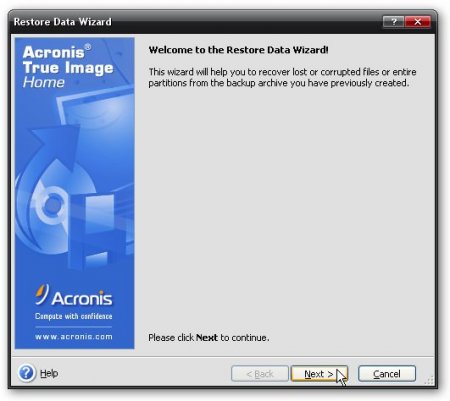
We select the image of the section. In our case, it was split into 2 parts for more convenient recording on DVDs. We select the first part, and Acronis will guess by itself that PQService2 is the second part.
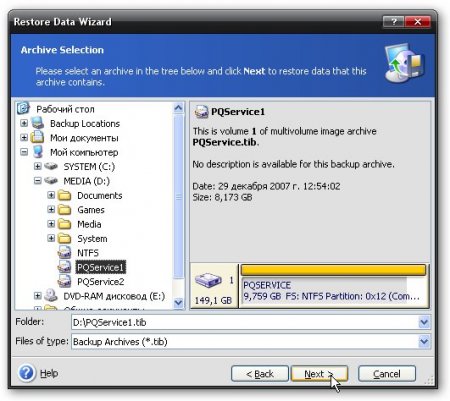
We press Next
Choosing to recover disks or partitions
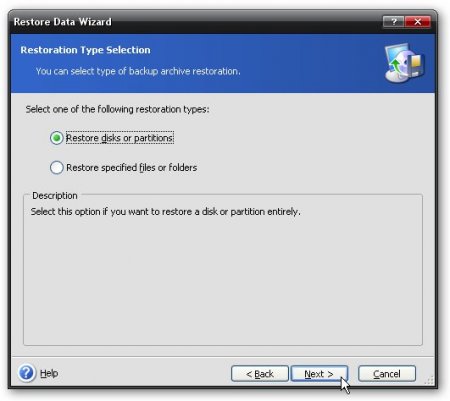
Acronis True Image supports writing multiple sections to one image file. When we made images of hidden partitions, we wrote one partition into one image file. We indicate the only section from the image file:

Specify the default parameters and click Next

To start the process of restoring partitions from an image, click Proceed

A window like this will appear

when the recovery is complete - click OK
To make life easier for users, Acer has developed technology eRecovery which includes the application itself Acer eRecovery, as well as a hidden partition on the hard drive with a volume of several gigabytes. As a rule, on Acer laptops this section is called PQService... Main function Acer eRecovery- restoring the operating system along with preinstalled programs and drivers as at the time of purchase of the laptop. Looking ahead, I note that to restore the operating system with programs and drivers, you must press when the laptop boots up at the moment a white screen appears with the inscription Acer keyboard shortcut ALT + F10... On laptops ASUS, for example, you need to press the key F9... Information from the C: drive is erased, but from D: and other partitions - not. As a result, in about an hour the laptop will have an OS with programs and drivers as at the time of purchase.
Consideration of technology Acer eRecovery it is logical to start with a description of the program Acer eRecovery which comes pre-installed on Acer notebooks. At the first start, this program asks for a password:

Click on the button Setup and then on Create New a Password

In the upper window, enter the password, on average, enter it again for confirmation, and in the bottom window, enter the hint

If everything went well, we get such a window and click OK

I will explain why that password. It must be entered when restoring the system. Recovery will not start without entering this password. It's done Acer for security. When restoring, all information from the C: drive is erased. If an unauthorized person gains access to the laptop, then he can intentionally / unintentionally press ALT + F10 while loading and all information (including valuable information) on the C: drive would be erased. But if he does not know the password, then he will fail. If you do not know the password, you can find it out by reading the FAQ
Now let's go directly to the program itself. At the bottom of the main window you can see 3 tabs Backup, Burn disc and Restore... I will describe the tab first Backup

At the top you can see 2 buttons Full and Fast... I will explain why they are needed. If you press the button Full, then the process of creating a system restore point will begin, in other words, the entire contents of the disk WITH: is archived and at any time you can restore the state of the system at the time of the backup. The process of creating a restore point begins by specifying its name:

We press Next and a window appears with a warning that the restore point takes up quite a lot of disk space and it is recommended to close all applications before starting the backup process:

We choose Yes and click Next... After that, the process of creating a restore point starts:

When the creation is complete, click OK

Now I will explain what the button is for Fast

By clicking on this button, we start the incremental archiving process. This means that only changes are recorded in the archive compared to the original archive, which we made by clicking on the button Full... The modified files take up significantly less space and the archiving process is much faster. At the bottom of the main window, you can check the box next to Notify me if the change from last incremental backup is more than This checkbox enables notifications if the size of changes since the last incremental archiving exceeds a certain amount, which is indicated in the window. The incremental backup process begins by specifying a recovery point name:

Then the program asks us to close all applications before starting archiving, and also notifies that the archive takes up a certain amount of space on the hard disk. To start the process, select Yes and press Next
When the archiving process is completed, click OK

As a result, we will have one complete archive, which contains all the information from the C: drive, as well as one incremental archive, which contains only the changes after the creation of the main archive.

If we want to restore the state of the system (more precisely, the contents of the C :) drive at the time of archiving, press the button Restore... Recovery archives are stored in a hidden folder D: erData
Moving on to the description of the tab Burn disc... We have already encountered it in this material.
There are 4 buttons on it:

Create factory defeault disc- by clicking on this button, we will start burning recovery discs from which you can restore the entire system with drivers and programs as at the time of purchase of a laptop. It is necessary to make these discs MANDATORY
Create user backup disc- writing a restore point to disks, which is essentially the archived contents of the C: drive. This button will be active only when a full archive is made (to create it - on the tab Backup we press Full).
Create current system configuration backup disc- if you click on this button, then the contents of the C: drive are first archived, and then written to the disks.
Create- distributions of all programs and drivers that come with the laptop are written to the disk. This disk is necessary MANDATORY make.
When you click on the buttons, the following entry window opens:

The top indicates how many disks are needed. To start recording, click Next
Consider the tab Restore

This tab, like the previous one, contains 4 buttons. I will describe them in order:
Restore system to factory defeault- OS recovery with drivers and programs from hidden partitions. Information from the C: drive is erased, but not from other drives.
Restore system from user "s backup- restore the system from the user's restore point.
Recover system from CD / DVD- OS recovery with drivers and programs using Factory defeault disc
Reinstall applications / drivers- reinstall programs and / or drivers. If you click on this button, this window will open:

We press the button Install and in the menu on the left, select programs or drivers:

In the list, we are looking for the application / driver we are interested in and click Install ... for installation:

I think this is where we can finish with the description of the utility. Acer eRecovery
Now let's move on to the fun part - hidden sections.
It makes sense to start looking at the hidden sections with a brief description of their contents. In order to view the contents of the hidden partitions, we will use the Acronis True Image 10 utility (mirror) and directly the images of the hidden partitions. How to do them is described
Launch Acronis True Image 10 and on the menu Tools select item Explore Backup Archive

Select the image of the hidden section (if the image consists of several pieces, then select the first one) and click Open

We open the archive. The screenshot shows the approximate contents of the section PQService

In folder RYTOOLS there is a utility for working with MBR and the MBR itself.

In folder D2D / IMAGES posted a recovery image of partition C: laptop:

And here is the content of the second hidden section NTFS laptop Acer Aspire 5920
![]()
This section is used to implement the Acer IOArcade technology - loading a media center based on a stripped-down version of Windows XP by pressing the button with a little man on the right. This section contains Windows XPe and Acer Arcade.
I will describe how you can restore this partition with only Driver & application backup disc... To do this, using the utility for working with partitions (Acronis Disc Director Suite 10, for example), create a regular NTFS partition with a volume of 3.248 GB at the end of the hard drive, create a file in notepad that contains 11 units (11111111111 ) and call it Arcade.dat... Move this file to the created 3.248GB partition. Then all that remains is to find on Driver & application backup disc folder IOArcade and start the installation.
If someone needs an image of the hidden section of IOArcade - DOWNLOAD FROM HERE(thank you so much Sleganzov)
We have superficially sorted out the structure of hidden partitions, now we will consider the issue of their recovery. For this we need:
- made Acronis True Image images of sections. .
- Acronis True Image 10 (I do not recommend version 11 because of possible blue screens while loading)
- Acronis Disc Director Suite 10 (This program is offered for informational purposes only. Using this program you agree to uninstall it within 30 days or purchase it to continue using, copyright must be respected)
- It is recommended to download this bootable disk image as well, which may help recovery. (This program is offered for informational purposes only. By using this program you agree to uninstall it within 30 days or purchase it to continue using, copyright must be respected)
Suppose that when restoring hidden partitions, we repartition the hard drive and install Windows XP. The recovery procedure for Windows Vista is the same. Hidden partitions are stored on drive D:
Warning: any operations with partitions pose a potential risk to your information. Therefore, it is better to write all critical information to discs or to another computer.
Let's start. First of all, we need to find out the exact size of the hidden partitions. To do this, run Acronis True Image 10 and click Try now... Demo still
![]()
On the menu Tools select item Explore Backup Archive

We select first the first section

and see its size. In our case, this is 9.759 GB ... we write this figure somewhere on a piece of paper
Then we select the second one (if you have only one hidden partition on your laptop, skip this step)

rewrite the size to the same piece of paper. In our case, it is 3.241 GB
Launch and select from the menu Manual mode (Manual mode)
The program window opens. At the top we see a list of partitions on the hard drive.
Note: If the size of the C: drive is less than 20 GB, then it is recommended to first reduce the size of the D: drive and, at the expense of the free space, increase the size of the C: drive to 20 gigabytes or more. This is necessary so that the C: partition does not overflow during the recovery process due to its insufficient size.
While resizing with Acronis Disc Director Suite 10 information NOT REMOVED.
When we have put things in order with the size of the C: drive, then you can proceed to the direct restoration of the partition (s) .First of all, you need to create using Acronis Disc Director Suite 10 free areas with dimensions that correspond to the dimensions of the hidden partitions. We will create these areas by reducing the size of the D: drive. When creating free areas for partitions, it is VERY IMPORTANT that their placement on the disk matches the original. That is, if the hidden partition was at the beginning of the disk, then the area for it must be created at the beginning of the disk, if the hidden partition was originally at the end of the disk, then you need to create an area of free space for the hidden partition at the end of the disk. This is a very important point, otherwise it is quite possible that automatic recovery will not want to work.
To create free areas, click on the D: drive with the right button and select Resize

This window opens:

Unallocated space before- this window sets the size of the free area in front of the section. In our case, the hidden section NTFS should be at the beginning of the disk, so we indicate its size, which was previously rewritten from Acronis True Image 10 PQService and it is located in BEGINNING DISC Unallocated space after leave zero.
Unallocated space after- this window sets the size of the free area after the partition. In our case, the section is a hidden section PQService should be at the end of the disk, so we indicate its size, which was previously copied from Acronis True Image 10... If you have only one section - PQService and it is located in DISC END, then we indicate its size in this window. In this case, in the field Unallocated space before leave zero.
Push OK and we get something like this. Everything is as we asked. Before partition D: 3.248 GB of free space, and after that - 9.759 GB. Now we need to move the C: partition so that at the very beginning of the hard drive there is a free space of the size that we set in the field Unallocated space before when the D: partition was resized. If you have only one section, which is located in DISC END, you can skip this step because there is no free space in front of the D: section and there is simply nowhere to move the C: section. After the D: drive, you should have a free area with a size equal to the size of your hidden partition.
We click on the C drive: right-click and select from the menu Resize

In the window that appears, simply move the C: section all the way to the right:

Push OK and we get something like this

Unallocated area in front of drive C: for partition NTFS and an unallocated area for the section PQService after drive D:
Note: all changes are carried out after restarting the laptop, any change can be canceled by clicking on the blue arrow at the top of the program.
To apply the changes, click on the checkbox, then on the button Proceed:
Acer laptops are very popular today. In fact, this is one of the most common laptops among the citizens of our country. This is due to the fact that it has good performance and high quality work. But when you buy, not all models come with a pre-installed OS, so you should know how 7 on Acer.
Installation process
BIOS on Acer laptops is standard, it includes various elements of the UEFI system. It is for this reason that the Acer is a rather difficult task for unprepared users. From the very beginning, these same UEFI options must be disabled and after that you can proceed directly to the installation.
First you need to pay attention to the fact that the Acer laptop itself, on which you are going to install the operating Windows system 7, Supports floppy drive or USB connectors. To do this, you need to go into the BIOS, for which at the very beginning when loading, you need to press the F2 key, go to the initial BIOS section (BOOT) and press the F5 and F6 keys (depending on what you will be using - DVD or USB connector, - put a suitable device in priority).

After that, you need to go to the "Exit" tab and select the "Save" item. As soon as this is done, the download of all the necessary information will begin directly from the used drive, and only then from the computer's hard drive.
Immediately after that, it remains only to correctly indicate the most suitable edition of Windows 7. For example, if your Acer laptop is 64-bit, then you should install the 64-bit system accordingly. If you see the message "Press any key to boot from DVD or CD" on your screen, you just need to press any key - this way we accept the agreement on booting from DVD / CD and after that the boot starts.

If the installation for some reason did not start, then most likely this means that you have an outdated version of the laptop and you need to press the F10 key to enter the menu, and then everything is done as described above. But besides the above actions, it is highly discouraged to do anything else, especially if you do not have experience in carrying out this work. This can seriously affect the further performance of your computer. The most important thing here is that all actions must be performed in accordance with the specified instructions.
As soon as the 100% mark appears on the installation progress indicator, the computer will be restarted and that's it - Windows installation 7 on Acer laptop completed successfully.
Using helper utilities
You can also do a little differently using the standard True Acronis Image software.  From the very beginning, you simply make an image of the entire system drive C: (in short, all files on the C: drive are packed into an archive), and after that, if necessary, you can simply return the system state to its original state. This way, you will not only install Windows 7 on your Acer laptop, but also save your most important files.
From the very beginning, you simply make an image of the entire system drive C: (in short, all files on the C: drive are packed into an archive), and after that, if necessary, you can simply return the system state to its original state. This way, you will not only install Windows 7 on your Acer laptop, but also save your most important files.
 Alternatives to Replace Microsoft Office Visio Command Line Key
Alternatives to Replace Microsoft Office Visio Command Line Key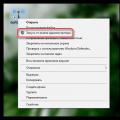 Mhotspot installation and setup Computer did not restart after installation
Mhotspot installation and setup Computer did not restart after installation A tale of three buttons. Column by Evgeny Zobnin. We get customizable on-screen buttons Home, Back and Menu on any Android device (Floating Soft Keys) Assigning buttons on the phone
A tale of three buttons. Column by Evgeny Zobnin. We get customizable on-screen buttons Home, Back and Menu on any Android device (Floating Soft Keys) Assigning buttons on the phone